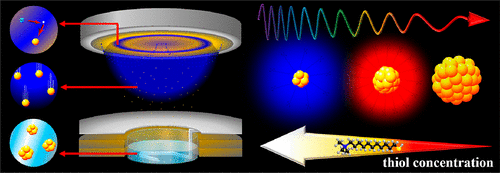当前位置:
X-MOL 学术
›
Acc. Chem. Res.
›
论文详情
Our official English website, www.x-mol.net, welcomes your feedback! (Note: you will need to create a separate account there.)
Matrix Sputtering Method: A Novel Physical Approach for Photoluminescent Noble Metal Nanoclusters
Accounts of Chemical Research ( IF 18.3 ) Pub Date : 2017-11-30 00:00:00 , DOI: 10.1021/acs.accounts.7b00470 Yohei Ishida 1 , Ryan D. Corpuz 1 , Tetsu Yonezawa 1
Accounts of Chemical Research ( IF 18.3 ) Pub Date : 2017-11-30 00:00:00 , DOI: 10.1021/acs.accounts.7b00470 Yohei Ishida 1 , Ryan D. Corpuz 1 , Tetsu Yonezawa 1
Affiliation

|
Noble metal nanoclusters are believed to be the transition between single metal atoms, which show distinct optical properties, and metal nanoparticles, which show characteristic plasmon absorbance. The interesting properties of these materials emerge when the particle size is well below 2 nm, such as photoluminescence, which has potential application particularly in biomedical fields. These photoluminescent ultrasmall nanoclusters are typically produced by chemical reduction, which limits their practical application because of the inherent toxicity of the reagents used in this method. Thus, alternative strategies are sought, particularly in terms of physical approaches, which are known as “greener alternatives,” to produce high-purity materials at high yields. Thus, a new approach using the sputtering technique was developed. This method was initially used to produce thin films using solid substrates; now it can be applied even with liquid substrates such as ionic liquids or polyethylene glycol as long as these liquids have a low vapor pressure. This revolutionary development has opened up new areas of research, particularly for the synthesis of colloidal nanoparticles with dimensions below 10 nm. We are among the first to apply the sputtering technique to the physical synthesis of photoluminescent noble metal nanoclusters. Although typical sputtering systems have relied on the effect of surface composition and viscosity of the liquid matrix on controlling particle diameters, which only resulted in diameters ca. 3–10 nm, that were all plasmonic, our new approach introduced thiol molecules as stabilizers inspired from chemical methods. In the chemical syntheses of metal nanoparticles, controlling the concentration ratio between metal ions and stabilizing reagents is a possible means of systematic size control. However, it was not clear whether this would be applicable in a sputtering system. Our latest results showed that we were able to generically produce a variety of photoluminescent monometallic nanoclusters of Au, Ag, and Cu, all of which showed stable emission in both solution and solid form via our matrix sputtering method with the induction of cationic-, neutral-, and anionic-charged thiol ligands. We also succeeded in synthesizing photoluminescent bimetallic Au–Ag nanoclusters that showed tunable emission within the UV–NIR region by controlling the composition of the atomic ratio by a double-target sputtering technique. Most importantly, we have revealed the formation mechanism of these unique photoluminescent nanoclusters by sputtering, which had relatively larger diameters (ca. 1–3 nm) as determined using TEM and stronger emission quantum yield (max. 16.1%) as compared to typical photoluminescent nanoclusters prepared by chemical means. We believe the high tunability of sputtering systems presented here has significant advantages for creating novel photoluminescent nanoclusters as a complementary strategy to common chemical methods. This Account highlights our journey toward understanding the photophysical properties and formation mechanism of photoluminescent noble metal nanoclusters via the sputtering method, a novel strategy that will contribute widely to the body of scientific knowledge of metal nanoparticles and nanoclusters.
中文翻译:

基质溅射法:光致发光贵金属纳米团簇的一种新型物理方法
贵金属纳米簇被认为是显示出独特光学特性的单个金属原子与显示出特征性等离子体吸收的金属纳米颗粒之间的过渡。当粒径远低于2 nm时,这些材料就会表现出令人感兴趣的特性,例如光致发光,尤其在生物医学领域具有潜在的应用前景。这些光致发光的超小纳米簇通常通过化学还原来生产,由于该方法中所用试剂的固有毒性,限制了它们的实际应用。因此,寻求替代策略,尤其是在物理方法方面,被称为“绿色替代方案”,以高产量生产高纯度材料。因此,开发了一种使用溅射技术的新方法。该方法最初用于使用固体基材生产薄膜;现在,即使这些液体的蒸气压低,它也可以与离子液体或聚乙二醇等液体基质一起使用。这一革命性的发展开辟了新的研究领域,尤其是用于合成尺寸小于10 nm的胶体纳米颗粒。我们是第一个将溅射技术应用于光致发光贵金属纳米团簇的物理合成的公司。尽管典型的溅射系统依赖于表面组成和液体基体的粘度对控制粒径的影响,但这仅导致直径约为1。3–10 nm都是等离子的,我们的新方法引入了硫醇分子作为稳定剂,受到化学方法的启发。在金属纳米粒子的化学合成中,控制金属离子与稳定剂之间的浓度比是系统控制尺寸的一种可能方法。但是,尚不清楚这是否适用于溅射系统。我们的最新结果表明,我们能够一般地生产各种光致发光的金,银和铜的单金属纳米簇,通过我们的矩阵溅射方法(通过诱导阳离子,中性),所有这些溶液均以溶液和固体形式显示稳定的发射。 -和带阴离子电荷的硫醇配体。我们还成功地通过双靶溅射技术控制原子比的组成,合成了在UV-NIR区域内显示可调发射的光致发光双金属Au-Ag纳米团簇。最重要的是,我们已经揭示了这些独特的通过溅射形成的光致发光纳米团簇的形成机理,与通过光电子显微镜制备的典型光致发光纳米团簇相比,其通过TEM测定具有相对较大的直径(约1-3 nm),并且具有更大的发射量子产率(最大16.1%)。化学手段。我们认为,此处介绍的溅射系统的高可调性具有显着的优势,可以创建新颖的光致发光纳米团簇,作为对常规化学方法的补充策略。该报告重点介绍了我们通过溅射方法了解光致发光贵金属纳米团簇的光物理性质和形成机理的旅程,该新颖的策略将广泛促进金属纳米颗粒和纳米团簇的科学知识体系。
更新日期:2017-11-30
中文翻译:

基质溅射法:光致发光贵金属纳米团簇的一种新型物理方法
贵金属纳米簇被认为是显示出独特光学特性的单个金属原子与显示出特征性等离子体吸收的金属纳米颗粒之间的过渡。当粒径远低于2 nm时,这些材料就会表现出令人感兴趣的特性,例如光致发光,尤其在生物医学领域具有潜在的应用前景。这些光致发光的超小纳米簇通常通过化学还原来生产,由于该方法中所用试剂的固有毒性,限制了它们的实际应用。因此,寻求替代策略,尤其是在物理方法方面,被称为“绿色替代方案”,以高产量生产高纯度材料。因此,开发了一种使用溅射技术的新方法。该方法最初用于使用固体基材生产薄膜;现在,即使这些液体的蒸气压低,它也可以与离子液体或聚乙二醇等液体基质一起使用。这一革命性的发展开辟了新的研究领域,尤其是用于合成尺寸小于10 nm的胶体纳米颗粒。我们是第一个将溅射技术应用于光致发光贵金属纳米团簇的物理合成的公司。尽管典型的溅射系统依赖于表面组成和液体基体的粘度对控制粒径的影响,但这仅导致直径约为1。3–10 nm都是等离子的,我们的新方法引入了硫醇分子作为稳定剂,受到化学方法的启发。在金属纳米粒子的化学合成中,控制金属离子与稳定剂之间的浓度比是系统控制尺寸的一种可能方法。但是,尚不清楚这是否适用于溅射系统。我们的最新结果表明,我们能够一般地生产各种光致发光的金,银和铜的单金属纳米簇,通过我们的矩阵溅射方法(通过诱导阳离子,中性),所有这些溶液均以溶液和固体形式显示稳定的发射。 -和带阴离子电荷的硫醇配体。我们还成功地通过双靶溅射技术控制原子比的组成,合成了在UV-NIR区域内显示可调发射的光致发光双金属Au-Ag纳米团簇。最重要的是,我们已经揭示了这些独特的通过溅射形成的光致发光纳米团簇的形成机理,与通过光电子显微镜制备的典型光致发光纳米团簇相比,其通过TEM测定具有相对较大的直径(约1-3 nm),并且具有更大的发射量子产率(最大16.1%)。化学手段。我们认为,此处介绍的溅射系统的高可调性具有显着的优势,可以创建新颖的光致发光纳米团簇,作为对常规化学方法的补充策略。该报告重点介绍了我们通过溅射方法了解光致发光贵金属纳米团簇的光物理性质和形成机理的旅程,该新颖的策略将广泛促进金属纳米颗粒和纳米团簇的科学知识体系。



























 京公网安备 11010802027423号
京公网安备 11010802027423号